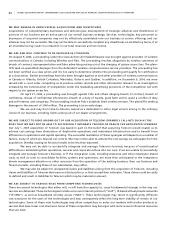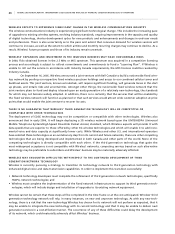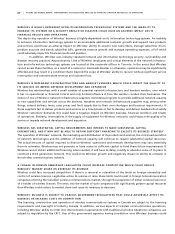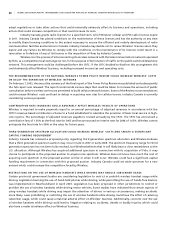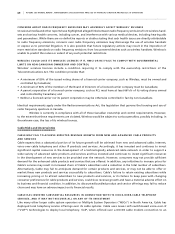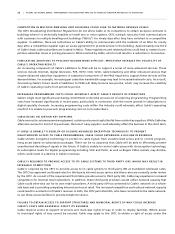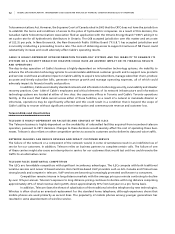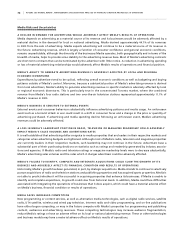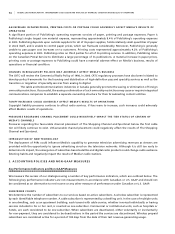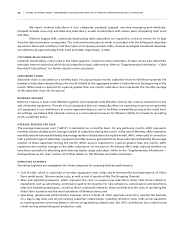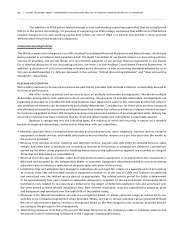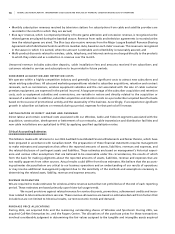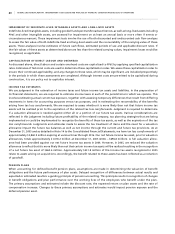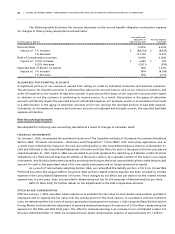Rogers 2005 Annual Report Download - page 75
Download and view the complete annual report
Please find page 75 of the 2005 Rogers annual report below. You can navigate through the pages in the report by either clicking on the pages listed below, or by using the keyword search tool below to find specific information within the annual report.
71 ROGERS 2005 ANNUAL REPORT . MANAGEMENT’S DISCUSSION AND ANALYSIS OF FINANCIAL CONDITION AND RESULTS OF OPERATIONS
CO M P ET I TI O N I N M U LT I PL E DW E LL I NG U NI T B U ILD I NG S C O ULD LE A D T O M A TE R IA L RE V EN U E L OSS E S
The CRTC Broadcasting Distribution Regulations do not allow Cable or its competitors to obtain exclusive contracts in
buildings where it is technically feasible to install two or more systems. CRTC winback rules also limit communications
with customers in multiple dwelling unit buildings (“MDUs”) for ninety days after they have switched to a competitive
supplier. In addition, there are restrictions on Cable’s ability to communicate with the residents of an MDU for ninety
days after a competitive supplier signs an access agreement to provide service in the building. Approximately one-third
of Cable’s basic cable subscribers are located in MDUs. These regulations and related policies could lead to material com-
petitive subscriber losses or pricing pressure in MDUs serviced by Cable, which could result in a reduction in its revenue.
FO R E CA S TI N G A D DI T IO N S T O P P &E MA Y BE C OM E MO R E D IF F ICU L T, WH I CH M AY IN C REA S E T HE V OL A TI L IT Y OF
CA B L E’ S O P ER A T IN G R E SU L T S
An increasing component of Cable’s additions to PP&E will be to support a series of more advanced services. These
services include Internet, digital television, PVR, HDTV, VOD, SVOD, cable telephony and other enhanced services that
require advanced subscriber equipment. A substantial component of the PP&E required to support these services will be
demand driven. For example, increasing per subscriber bandwidth usage may lead to increased network costs. As a result,
forecasting Cable’s future levels of additions to PP&E will likely become less precise, which may increase the volatility
of Cable’s operating results from period-to-period.
IN C R EA S IN G P R O GR A MM I NG C OS T S C OU L D A D VE R SEL Y A F FE C T C A BL E ’S RES U LT S O F OP E RA T IO N S
Cable’s single most significant purchasing commitment is the total annual cost of acquiring programming. Programming
costs have increased significantly in recent years, particularly in connection with the recent growth in subscriptions to
digital specialty channels. Increasing programming costs within the industry could adversely affect Cable’s operating
results if it is unable to pass such programming costs on to its subscribers.
CA B L E R EL I ES O N C ER T AI N KE Y S U PP L I ER S
Cable sources its customer premise equipment, certain services and capital builds from certain key suppliers. While Cable has
alternate sources for most of its purchases, the loss of a key supplier could adversely affect the business in the short term.
IF C AB L E I S U N AB L E T O D E VE L OP OR A CQ U IR E AD V AN C ED ENC R YP T IO N TE C HN O LO G Y T O P R EV E N T
UN A U TH O RI Z ED A CC E SS TO C AB L E P RO G R AM M IN G , C A BL E C O ULD EX P ER I ENC E A DE C LIN E I N R E V EN U ES
Cable utilizes encryption technology to protect its cable signals from unauthorized access and to control program-
ming access based on subscription packages. There can be no assurance that Cable will be able to effectively prevent
unauthorized decoding of signals in the future. If Cable is unable to control cable access with its encryption technology,
its subscription levels for digital programming including VOD and SVOD, as well as Rogers Video rentals, may decline,
which could result in a decline in Cable’s revenues.
CA B L E I S R EQ U I RE D T O P R O VI D E A CC E S S T O I TS C AB L E S YST E MS TO THI R D P AR T Y I S PS , W H I CH MA Y R E S UL T I N
IN C R EA S ED CO M P ET I TI O N
Cable is required by the CRTC to provide access to its cable systems to third party ISPs at mandated wholesale rates.
The CRTC has approved cost-based rates for third party Internet access service and those rates are currently under review
by the CRTC. As a result of the requirement that Cable provide access to third party ISPs, Cable may experience increased
competition for Internet retail subscribers. In addition, these third party providers would utilize network capacity that
Cable could otherwise use for its own retail subscribers. A third party ISP has connected to Cable’s network on a whole-
sale basis and is providing competing Internet services at retail. The increased competition and reduced network capacity
could result in a reduction of Cable’s revenue. In 2005, the CRTC permitted ISPs, who have connected to the cable network,
to use those access facilities to provide telephone service.
FA I L UR E T O O B T AI N A C CE S S T O S U PP O R T S TR U CTU R ES AN D MU N IC I PA L RI G HT S O F WA Y C O UL D IN C RE A SE
CA B L E’ S C O ST S AN D A D VE R S EL Y A F FE C T I T S B USI N ES S
Cable requires access to support structures and municipal rights of way in order to deploy facilities. Where access
to municipal rights of way cannot be secured, Cable may apply to the CRTC to obtain a right of access under the





